
Torilis japonica (Japanese Hedge Parsley)…
Hello everyone! I hope this post finds you well. October is here once again and some of the wildflowers aren’t looking their best. There are a lot of insects and butterflies feeding right now. I have taken a lot of photos the last few days and I am getting behind. 🙂 I now have 655 observations posted on iNaturalist covering 343 species.
This saga of the wild weeds (and wildflowers) and problem areas on the farm continues as I walked out of the main hayfield to the front pasture…
The above photo is the dreaded Torilis japonica (Japanese Hedge Parsley). There doesn’t seem to be as much of this stuff growing as there has been in the past. That is certainly fine with me…
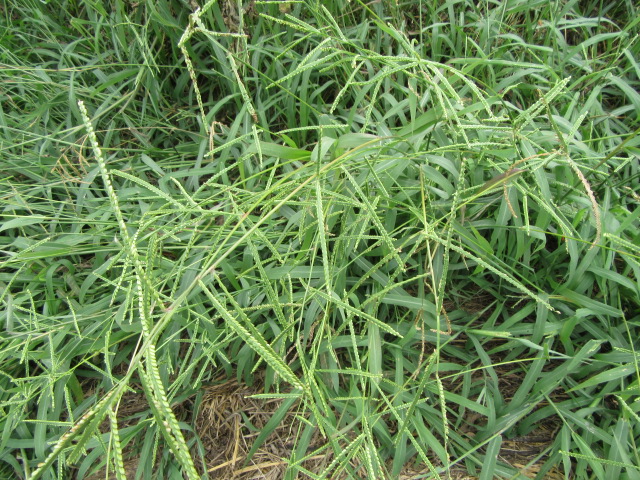
Eleusine indica (Goosegrass)…
As you can imagine, there are A LOT of different species of grass growing on the farm. Heck, pretty much every yard around the world has a lot of species of grass. I don’t know about you, but the worse grass in my yard and pastures has got to be the Eleusine indica (Goosegrass). It is the grass with very tough blades you have to mow over multiple times and even then it still looks raggy. The second worse is the crabgrass which I don’t really want to talk about…
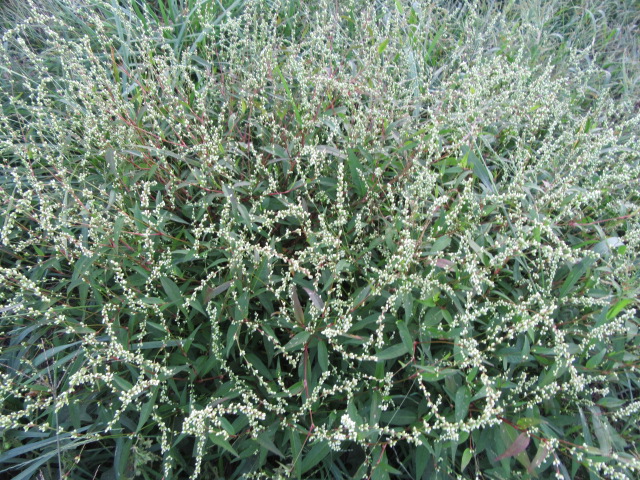
Persicaria hydropiper (Water Pepper)…
There are still a few fairly good-sized colonies of Persicaria hydropiper (Water Pepper) here and there but nothing like 2019 when I identified seven species. That was definitely the year for the Smartweeds.
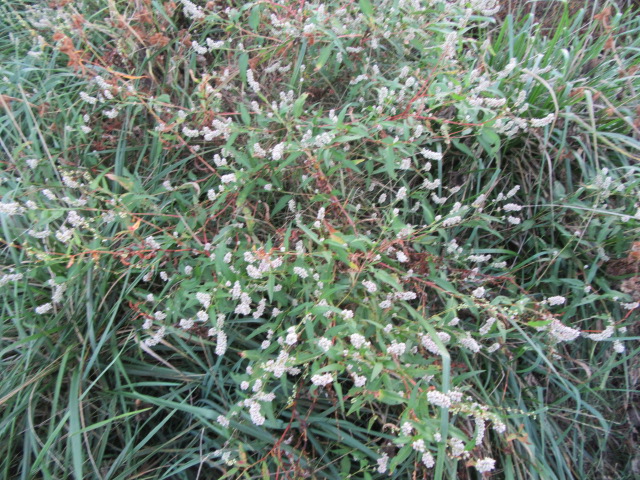
Persicaria pensylvanica (Pinkweed)…
The Persicaria pensylvanica (Pinkweed) is also scattered among the grass in the front pasture, mainly around the two old mulberry trees. The other six species are scattered about here and there.
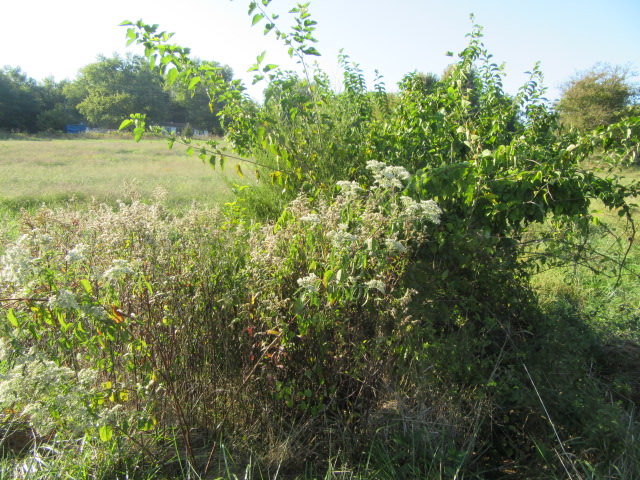
Hmmm…
I walked over to what used to be a smallish Multiflora Rose. Dad and I pulled up several rose bushes with the tractor a few years ago but left this one. It wasn’t that big and is it along the drainage area where water runs from the pond. When we pulled up the others it left a HUGE hole and I didn’t that that would be a good idea in this area. Three years ago a White Mulberry grew up in it, then last year I noticed a Celastrus scandens (American Bittersweet) in the mix. To the left is a small colony of Solidago (Goldenrod) and the other cluster is either Eupatorium altissimum (Tall Thoroughwort) or Eupatorium serotinum (Late Boneset/Late Thoroughwort). Those two species look a lot alike and I didn’t take a closer look…
Both of those species have seen better days throughout the farm. There are still quite a few Solidago in bloom along the main hayfield. I am not really sure which species of Solidago are growing here but likely Solidago altissima and maybe also S. gigantea. The galls on a few plants are generally found on both of those species.
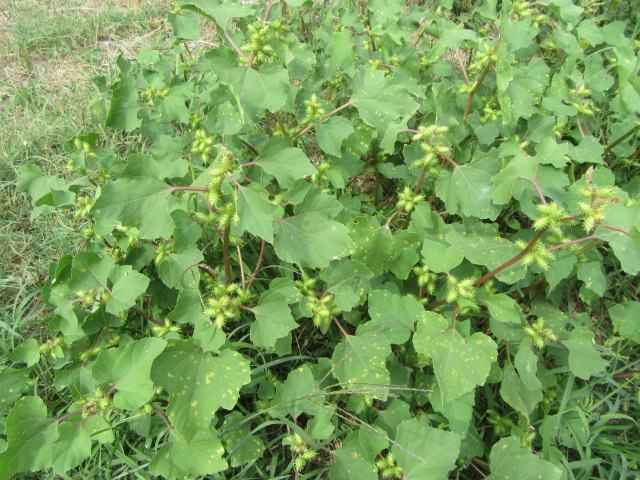
Xanthium strumarium (Rough Cocklebur)…
I am not really sure where I took this photo of the Xanthium strumarium (Rough Cocklebur). It is growing here and there and seems to be getting carried away again. I had been “working on it” for several years and seemed to pretty much have it whipped. Well, it seems to be coming back with reinforcements! I don’t have a page for the Cocklebur…
I walked across the ditch to get photos of what I saw as I started the walk. It was this mass of pink right behind the pond in the front pasture I had somehow just noticed. Probably because I hadn’t been paying attention, but that just can’t be. Just last week, or maybe the week before, I had taken photos of a few plants near the pond and I didn’t notice it then. I am saving the photos for the end of this post so I can end it well… 🙂
After I took some photos behind the pond, I walked toward the fence along the road in the front pasture to the biggest eyesore here…

Rhus glabra (Smooth Sumac)…
The Rhus glabra (Smooth Sumac) has spread into the pasture along the fence. This is a big problem…
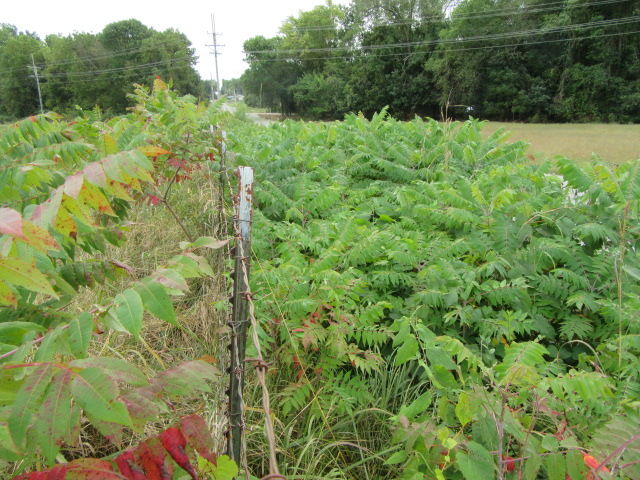
Rhus glabra (Smooth Sumac)…
I put the camera across the fence to get a photo of the mess between the fence and the street. In the first place, the fence is a little too close to the ditch, and the ditch is cut too steep to mow. Whoever did this had no concept of maintenance and it was done MANY years ago. The county used to come along several times during the summer but now we are lucky if they come once a year. At the end of the yard, there is a telephone pole between the fence and ditch making it impossible to get a mower along the fence. To mow the ditch, I would have to drive down the street to where the gate is and come up… Then, I would have to back the mower all the way back down to the gate… Since the ditch is cut like it is, and part of it has washed out a little, it is kind of unsafe. To fix this problem, the fence would have to be removed and moved back and the ditch smoothed out at a slope allowing it to be mowed safely. It is a real eyesore and I don’t like it one bit. I don’t like using chemicals, but this area needs cut and sprayed. Water from the ditch runs to the lake at the park… Perhaps I can talk to the county or the conservation department to find a solution.
I don’t want to sound like I am complaining because I am very thankful to be here. I have a lot to be thankful for. It seems like I have been given an opportunity and I would like to do much better but I am not quite sure how to go about it…
Getting closer to the surprise…
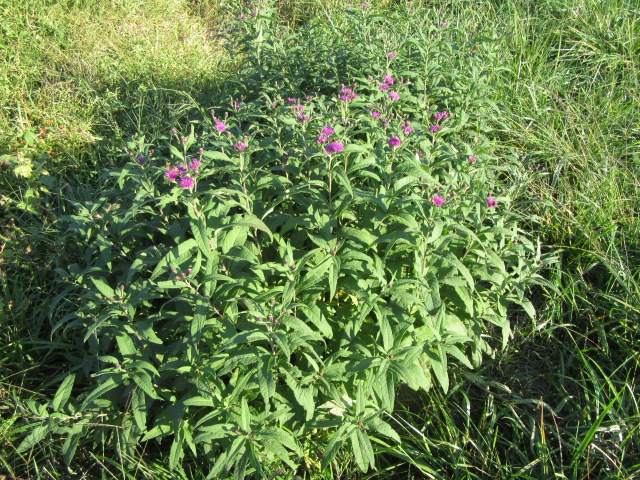
Vernonia missurica (Missouri Ironweed)…
One of the first plants to grow after the hay is cut is the Vernonia missurica (Missouri Ironweed). Over the years, trying to tell the difference between Verononia baldwinii (Western or Baldwin’s Ironweed) and V. missurica has been somewhat difficult. I know the difference but couldn’t find enough of the latter to get a good confirmation to prove to myself that’s what it was. To make it worse, the two species hybridize… Earlier, all the ironweed were definitely Vernonia baldwinii.

Vernonia missurica (Missouri Ironweed)…
Now, most of the ironweed are likely most definitely (GEEZ) Vernonia missurica. The heads have more florets (30+) and the involucral bracts are appressed. With Vernonia baldwinii, they have fewer florets and the bracts are recurved. I don’t have a page for the Vernonia missurica and the page for Vernonia baldwinii is still in draft mode. They have been driving me crazy so I wanted to make sure what I was talking about. Am I sure now? Well, not really. 🙂
OH, so here we go…
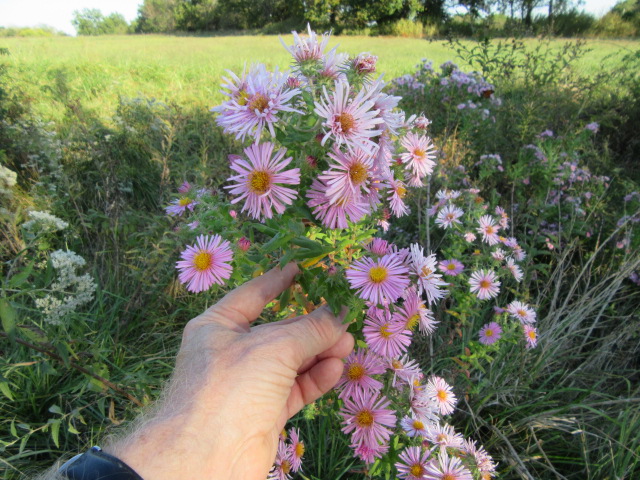
Symphyotrichum novae-angliae (New England Aster)… On 9-28-21…
Don’t laugh like I am. This is probably the first pink flowers I have gotten excited about in my life. For one, the Symphyotrichum novae-angliae (New England Aster) is the first species in the genus I have been able to properly identify and it become research grade on iNaturalist. The flowers are 1 1/2″ wide while the others are 1/2″ (more or less) and most commonly white or a pale lavender-pink. I am sure, almost, I have identified one species as Symphyotrichum pilosum (Hairy White Oldfield Aster) but I can’t get anyone on iNaturalist to stick their neck out and agree. I have submitted a few species that are difficult with the same results… Birds are easy and every species I have submitted are research grade.
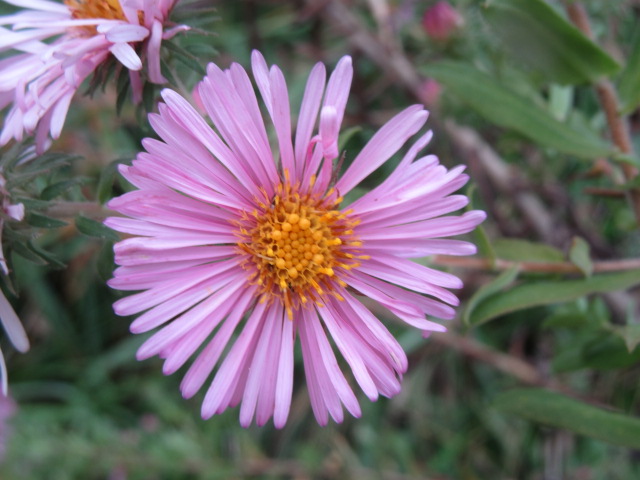
Symphyotrichum novae-angliae (New England Aster) on 9-30-21, 1 1/2″ diameter…
The Missouri Plants website lists 16 species of Symphyotrichum in Missouri and most are pink. The USDA Plants Database lists 154 accepted species (including infraspecific names)in North America. Plants of the World Online lists 95 species worldwide including 12 hybrids but not including possible varieties. To find that out, I would have had to click on 95 pages. For grins, I checked out The Plant List which hasn’t been maintained since 2013. It lists 143 species (including infraspecific names), a whopping 1,116 synonyms, and only 37 species unplaced at the time. I would count the list on the Wildflower Research website, but I am sort of exhausted…

the underside and upper leaves of the Symphyotrichum novae-angliae (New England Aster)…
Getting back to the Symphyotrichum novae-angliae… Information online says their flowers are purplish and rarely pink. Well, these are pink fading to white. It also says they supposedly grow to around 40″ or so tall. Hmmm… There is a problem. The huge clusters of pink flowers are on stems in a circle 10-12′ in diameter. One could mistakenly “think” the stems are 40″ or so tall. BUT, in the center of the circle, there is a cluster of bent over stems (at the base of the plant). I picked one of the stems up and it was about a foot taller than me and I am 5′ 8ish… The stems had gotten so heavy they fell over and curved upward (like sweet corn). I took more photos on the 30th, including the bent-over stems at the base of the plant. Unfortunately, the photos of the base of the plant were blurry so I will have to try AGAIN. Possibly take a tape measure (and photograph the measurement) to prove my point. That happened before with another species of Symphyotrichum growing along the fence in the front pasture. The stem was growing in the fence and it couldn’t fall over and was close to 8′ tall. I do have photos but I have never been able to identify the species…

Danaus plexippus (Monarch Butterfly) on the New England Aster…
There were a lot of small butterflies and insects were very busy. There was a single Monarch enjoying itself as well.
Jocelyn asked me to take a 20-30 minute video of the farm for her YouTube channel so, on Friday, October 2, I decided I would give it a shot. I took a video of the New England Asters and the butterflies then walked up the ditch toward the main hayfield. There was a large colony of Missouri Ironweed at the corner and there were more Monarch feeding than I ever saw before. There were several colonies of ironweeds scattered about halfway across the front of the hayfield so I continued recording. Then I walked to the back pasture where another pond is. There is a HUGE colony of ironweeds where I found HUNDREDS of Monarch feeding and it was quite a sight. There were even several Hummingbird Moths which are impossible to photograph but they came out quite well on the videos. Well, I took 17 videos normally 3 minutes or so each. A couple were 7 minutes because I got a little carried away and a few are around a minute because I had to stop recording to take photos. She will just have to splice the videos together to get 20 minutes or so. I have to upload the videos on Skype, and if I make them too long it takes forever and sometimes it won’t work at all. If I had a better way to do it I would…
Well, I better close for now. I took quite a few photos this past week and I need to do some catching up. 🙂 We have FINALLY gotten some rain…
Until next time, take care, be safe, and always be thankful!










